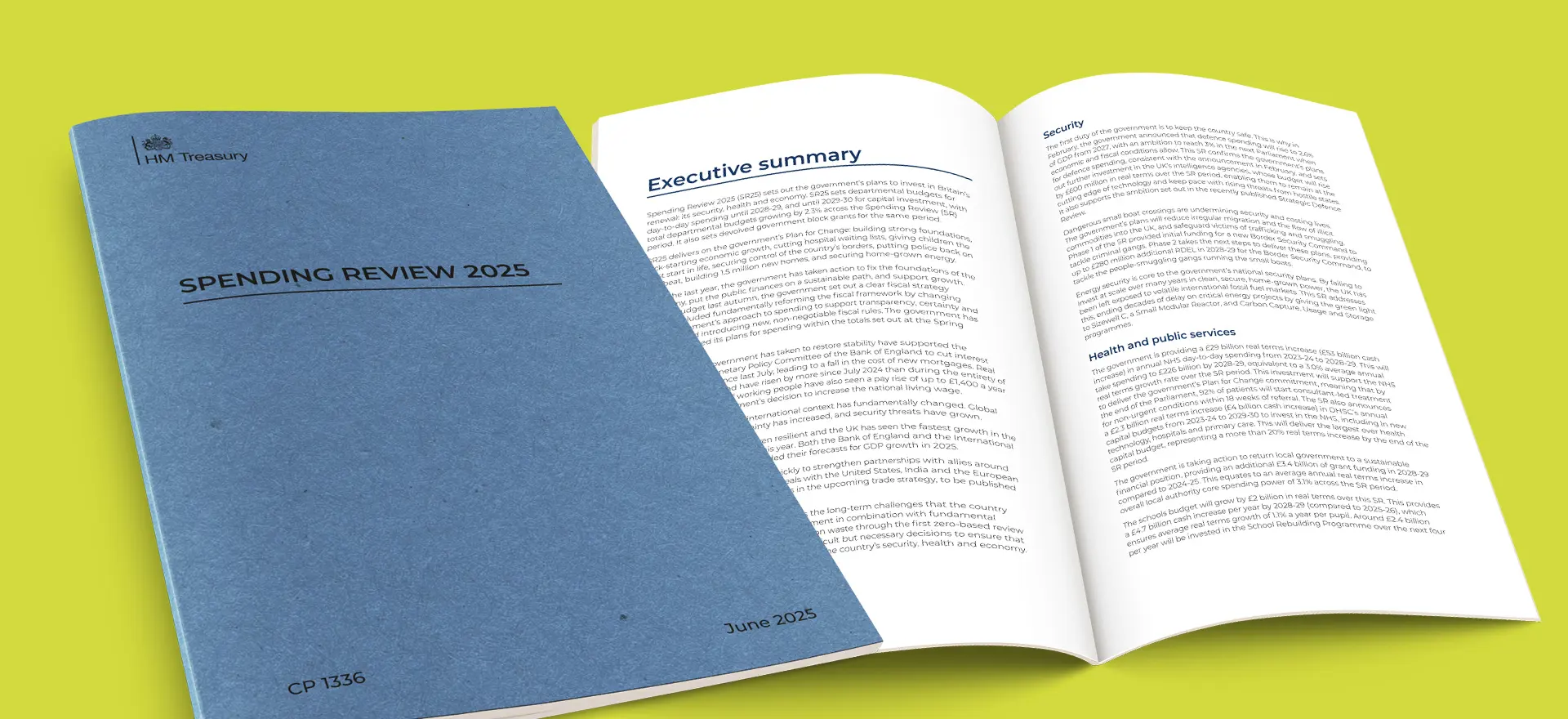The much-anticipated Spending Review delivered by The Chancellor to Parliament today has brought with it a cautiously positive outlook for the development and regeneration sectors albeit not without a sting in the tail. With these sectors in mind, our key takeaways are captured in four key themes all of which will be a primary focus for increased public sector investment in the period up to 2029:
Energy & defence
Without doubt the large capital injections for defence, security and energy will support significant economic and housing growth in key clusters across the country. This will include the stimulation of supply chains and skills development programmes throughout the UK, irrespective of where the major projects themselves are located.
Whilst (hopefully) not Trump-infected, The Chancellor dropped plenty of straplines which could be construed as ‘Making Britain Great Again’! Using the saving of British Steel as an example, she highlighted that the Spending Review was one which aimed to encourage ‘buying, making and selling more in Britain’. Similar sentiment was captured by her aim of making the UK a ‘defence industrial superpower’ and that ‘energy security means national security’. This industrial drive is backed by a commitment for increased Government R&D expenditure to £22 billion per year to 2029.
The thrust of The Chancellor’s message to restore advanced industrial capacity and autonomy to the UK where it can be viable to do so is encouraging from an economic development perspective. This approach is supported by a longer-term approach to Government investment although political sceptics can be forgiven for not being convinced!
Lichfields will comment further on the implications of the final Industrial Strategy when it is published in the coming weeks.
Places, communities & business cases
The Spending Review marks a revitalised and seemingly serious Government commitment to taking a place-based approach to investment, not least through the parallel publication of the findings of the Treasury Green Book Review (
Green Book Review 2025: Findings and actions - GOV.UK). The Green Book specifies how all projects and programmes promoted by the public need to be appraised. In doing so, it sets the framework for developing the business cases which must underpin decisions to invest or not.
Despite much political lip-service over the years, the Green Book Review acknowledges that the current guidance does not properly address the economic disparities that are evident across the country. Indeed, the Review explicitly states that ‘…many places have simply not received the investment they need to grow and flourish’. Moreover, it is candid and honest by highlighting that: ‘By design, business cases typically answer the question – what is the best way to undertake this project, rather than what is the right project to improve growth in this area?”. Positively, it sets out the key areas for action that will inform a subsequent update to the Green Book and thus the approach which will need to be taken to business cases aimed at ‘winning’ public sector funding for projects. We keenly await the outcome the Review and are optimistic that, compared to the last decade, the changes could ensure Government funding programmes aimed at regeneration and economic growth projects in the coming years are much more effective and targeted at the places which need it most.
Reflecting on the funding mechanisms applied by Government over the last decade, Lichfields will soon be issuing an Insight paper which seeks to provide guidance on how local authorities and other bodies can improve the business cases required to access public sector funding.
This fresh endorsement of a strongly place-based approach has been immediately translated into funding programmes promised today by the Chancellor. She has committed to providing a 10-year capital settlement through a new local growth fund, investing in up to 350 of the most deprived communities in the UK, confirming additional funding for mayoral strategic authorities through the Devolution Priority Programme and establishing the Growth Mission Fund. Whilst a budget has not yet been specified, the latter is designed to fast-track sound local growth projects that have previously failed to attract funding.
The Government’s intentions for places are clear: deliver growth where it is needed the most. This approach to funding hopefully will put local communities first and remove bureaucratic barriers to investment by ensuring Government guidance provides a proportionate framework for projects to make the case for investment, giving schemes a fighting start to secure the funding they need.
A key challenge for Government will be to ensure that access to these funds remains fair and equitable. In their Autumn Budget 2024, the Government committed to reforming local growth funding within Phase 2 of the Spending Review, including moving away from a competitive bidding process
[1]. Today’s Spending Review made no clear mention on the structure of funding programmes in the coming years. In order for Government to deliver on its commitment to places, it is imperative that there is a step change in the administration of funding, shifting away from a competitive to a more collaborative process.
Social & affordable housing
Housing was again close to being front and centre of the Spending Review. The mission to ‘renew Britain’ saw an overall shift in spending, tacking towards investment with £113bn to spend on infrastructure, and away from current spending by limiting day-to-day budget increases. Amongst the most significant commitment was the £39billion over the next 10 years of the affordable homes programme (AHP) – the Treasury and MHCLG describing it as the biggest boost to “social and affordable housing investment in a generation” and with significant
industry support. The flipside to this being that MHCLG, confronted with a significant workload (including another new NPPF, local government reorganisation, the devolution and PIN bills expected within a year) is facing a -15% cumulative real term fall in departmental administrative budget between 2025/26 and 2029/30.
Affordable housing undoubtedly has needed investment and arguably reform. On this front, the Government have gone further than many expected: £3.9bn each year is a lot more than the £2.3bn under the previous Government, a consultation on rent convergence would also allow them to secure their finances further and the 10 year settlement period rather than 5 offers much needed certainty for a sector which has been finding it difficult to finance investments in new stock.
The Government are also looking to lever in private investment using “financial transactions” which includes government backed loans and will be used for the upcoming mortgage guarantee scheme also announced. The Treasury announced that through these measures they will ‘
crowd in private investment’ and boost house building by confirming £4.8 billion in financial transactions from 2026-27 to 2029-30. This additional capacity will be managed by Homes England. Measures like these will be an important part of adding certainty to the industry looking to turnaround the historically
low number of homes built and granted permission in the last year.
The industry’s next question will be whether the AHP funding will be available for affordable housing under Section 106 agreements? The announcement of a ‘clearing service’ for section 106 housing opportunities in December signalled that the Government are acutely aware that there this is a growing issue, with
significant numbers of market housing developments being held back a lack of registered providers taking on Section 106 housing. Previous Lichfields analysis also found that on consented larger sites, those with a higher share of affordable housing built more quickly than others (likely due to higher absorption rates).
[2]If funding cannot be used in this way the impact will be more limited, leaving open market delivery stymied.
The Government has used the Spending Review to increase funding for affordable housing delivery and backing housebuilders more widely. This will help boost the rate of build out on sites with planning consents and will help with driving more permissions. Taken alongside the NPPF changes, the Planning and Infrastructure Bill, devolution bill and wider changes, the Government are clearly continuing to place housebuilding at the centre of their pro-growth strategy. To achieve 1.5million homes, or 300,000 homes delivered a year, the turnaround will need to be dramatic
[3] and immediate. It is yet to be seen whether the positive effects of new legislation, policy reform, and today’s funding allocations will be the necessary driver.
Transport infrastructure
Image credit: Matthew Waring via Unsplash
As for the investment in the new nuclear power plant – Sizewell C in Suffolk, pre-Spending Review announcements have already been made regarding the Government’s commitment to boosting investment in rail and other public transport projects, particularly in the North. This includes £15billion on tram, train and bus projects in mayoral authorities across the Midlands, the North and the West Country. On top of this is a commitment of £3.5 billion support to complete electrification of the cross-Pennine route, £2.5 billion for East-West Rail and a fourfold increase in local transport grants.
If planned and delivered in an integrated and collaborative manner, the local housing and economic growth benefits of these transport investments could be considerable.
If you operate in development, regeneration or economic development, there are many reasons to be cheerful from today’s Spending Review. Nevertheless, the Chancellor’s fiscal headroom remains very tight, so it will be intriguing to see if the measures announced today will mark the start of a genuinely sustained period of economic security and growth.
Footnotes
[1] Lichfields (2024): Autumn Budget 2024: Invest, Invest, Invest[2] Lichfields, 2024, Start to Finish 3[3] A 50% increase in housebuilding will be required to meet 300,000, from the 199,000 net additional homes estimated for 2024-2025 (MHCLG, 2025 Indicators of new supply). This will be made more difficult as just 233,7000 units were consented in the year to q1 2025, the lowest number of consented homes since 2014 (HBF 2025, Housing Pipeline).






